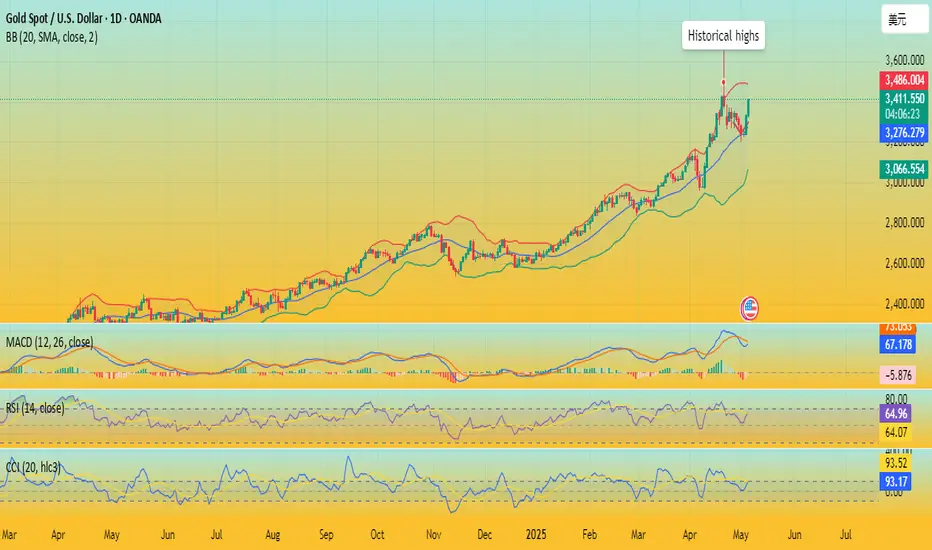Gold price breaks through the 3400 resistance level I predicted. And there is a trend of continuous rise.
Next, Quaid will comprehensively analyze the current market situation for all traders.
Technical analysis:
From the daily chart, the gold price has broken through the important resistance level and formed a strong upward trend. Currently trading above $3400, it has successfully broken through the key resistance range of $3385-3400. The Bollinger Band indicator shows that the middle track is at 3231.01, the upper track is at 3485.06, and the lower track is at 2976.97, indicating that the current price is near the upper track of the Bollinger Band, showing strong upward momentum.
The RSI indicator shows that the current value is 64.8, which is in the neutral to strong area, and has not yet reached the overbought level, and there is still room for growth.
Quaid believes that in the short term, if gold stabilizes above $3,400, it may hit $3,430-3,450. Once it breaks through, it will open up the possibility of a higher price.
Market sentiment observation:
The current market sentiment is clearly biased towards risk aversion, and global geopolitical tensions have become the main driving force for gold to rise. The continued tension of geopolitical conflicts and political uncertainty in Germany have prompted market participants to seek safe assets. At the same time, expectations for the Fed's future monetary policy shift are also increasing. Although the possibility of a rate cut in May is extremely low, the probability of a rate cut in the June meeting is close to 30%.
Liquidity indicators show that the trading activity in the gold market has increased and institutional funds continue to flow in, indicating that bullish sentiment in the market has the upper hand in the short term. Technical indicators have not shown obvious overbought signals, which means that the current rally still has room to continue. Compared with other asset classes, gold's relative strength is outstanding, especially in the context of the possible challenges to the status of the US dollar as a safe haven asset.
Outlook for the future
In the short term: Gold prices may continue to rise to test the $3,400-3,500 area. The Fed's decision will be a key trigger for gold prices in the near term. If the Fed shows a dovish attitude, gold prices are expected to further break through historical highs.
Medium term: Global geopolitical uncertainty is expected to continue to support gold prices. If geopolitical conflicts escalate further or the situation in the Middle East deteriorates, safe-haven demand may push gold prices to hit the $3,600 level. At the same time, market expectations of a shift in the Fed's monetary policy will be another key factor affecting gold prices.
Long term: From a macro perspective, the current combination of slowing global economic growth and geopolitical tensions will continue to provide support for gold.
Next, Quaid will comprehensively analyze the current market situation for all traders.
Technical analysis:
From the daily chart, the gold price has broken through the important resistance level and formed a strong upward trend. Currently trading above $3400, it has successfully broken through the key resistance range of $3385-3400. The Bollinger Band indicator shows that the middle track is at 3231.01, the upper track is at 3485.06, and the lower track is at 2976.97, indicating that the current price is near the upper track of the Bollinger Band, showing strong upward momentum.
The RSI indicator shows that the current value is 64.8, which is in the neutral to strong area, and has not yet reached the overbought level, and there is still room for growth.
Quaid believes that in the short term, if gold stabilizes above $3,400, it may hit $3,430-3,450. Once it breaks through, it will open up the possibility of a higher price.
Market sentiment observation:
The current market sentiment is clearly biased towards risk aversion, and global geopolitical tensions have become the main driving force for gold to rise. The continued tension of geopolitical conflicts and political uncertainty in Germany have prompted market participants to seek safe assets. At the same time, expectations for the Fed's future monetary policy shift are also increasing. Although the possibility of a rate cut in May is extremely low, the probability of a rate cut in the June meeting is close to 30%.
Liquidity indicators show that the trading activity in the gold market has increased and institutional funds continue to flow in, indicating that bullish sentiment in the market has the upper hand in the short term. Technical indicators have not shown obvious overbought signals, which means that the current rally still has room to continue. Compared with other asset classes, gold's relative strength is outstanding, especially in the context of the possible challenges to the status of the US dollar as a safe haven asset.
Outlook for the future
In the short term: Gold prices may continue to rise to test the $3,400-3,500 area. The Fed's decision will be a key trigger for gold prices in the near term. If the Fed shows a dovish attitude, gold prices are expected to further break through historical highs.
Medium term: Global geopolitical uncertainty is expected to continue to support gold prices. If geopolitical conflicts escalate further or the situation in the Middle East deteriorates, safe-haven demand may push gold prices to hit the $3,600 level. At the same time, market expectations of a shift in the Fed's monetary policy will be another key factor affecting gold prices.
Long term: From a macro perspective, the current combination of slowing global economic growth and geopolitical tensions will continue to provide support for gold.
相關出版品
免責聲明
這些資訊和出版物並不意味著也不構成TradingView提供或認可的金融、投資、交易或其他類型的意見或建議。請在使用條款閱讀更多資訊。
